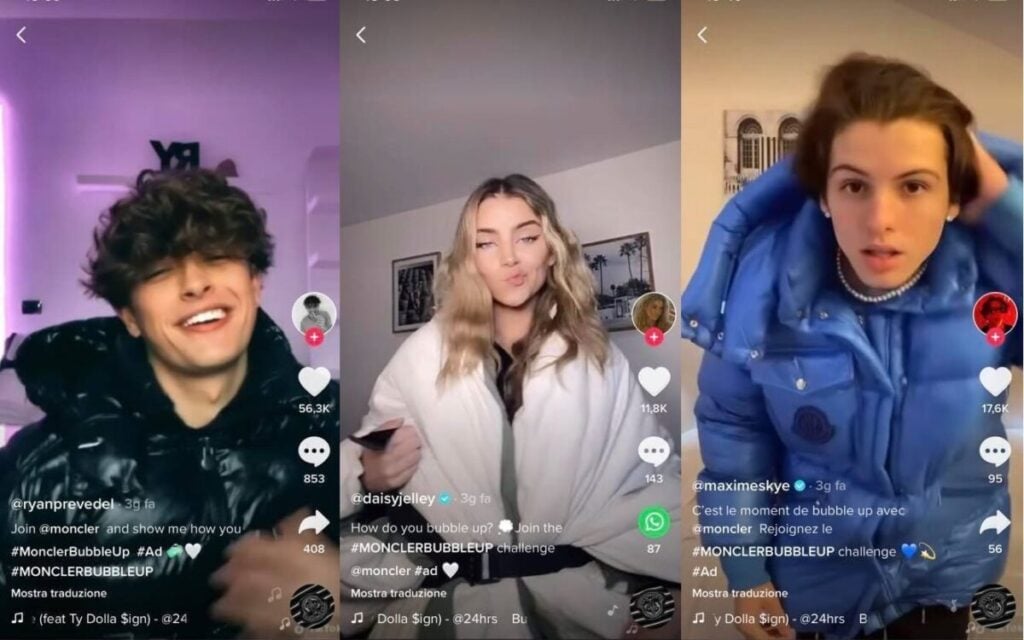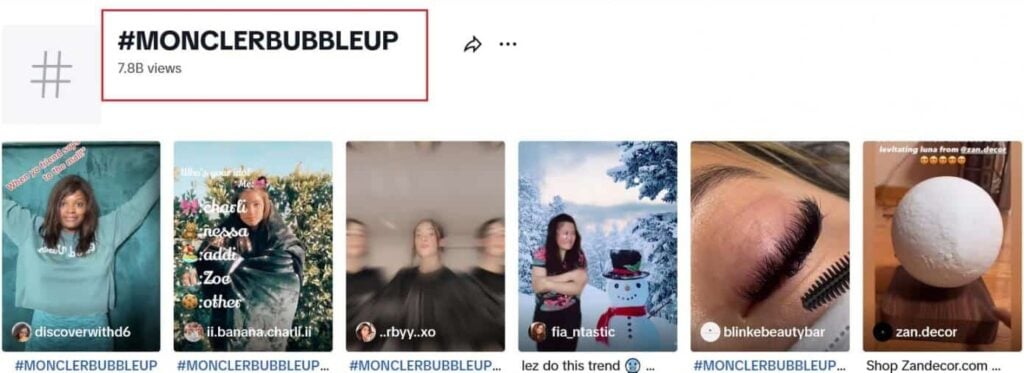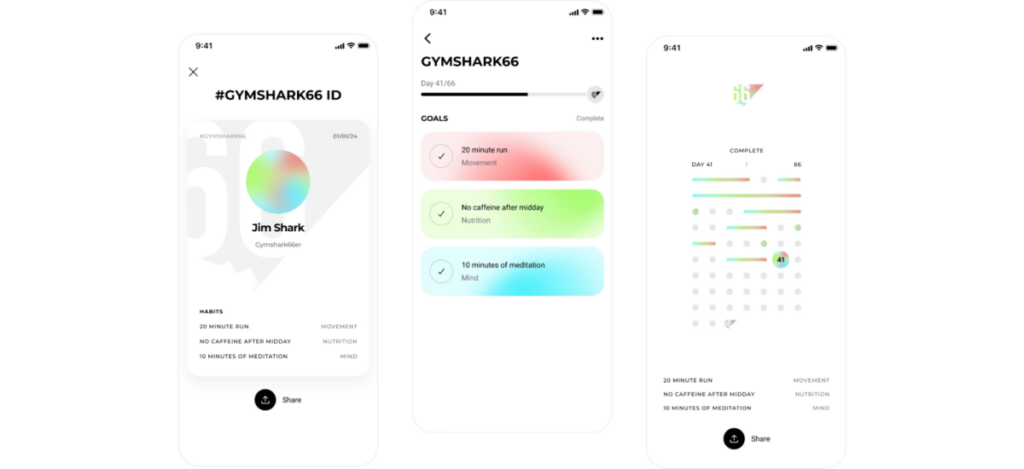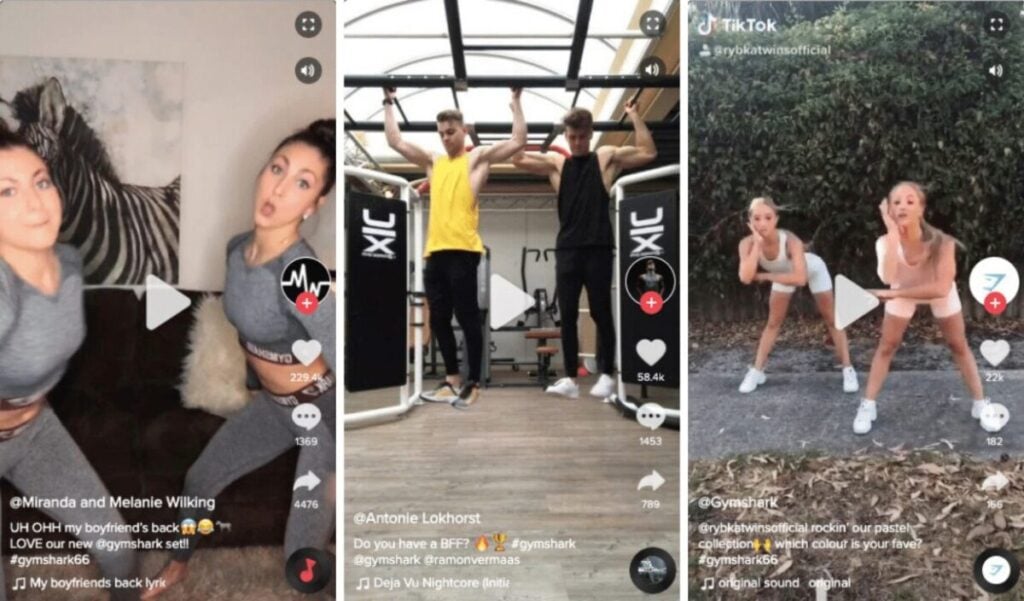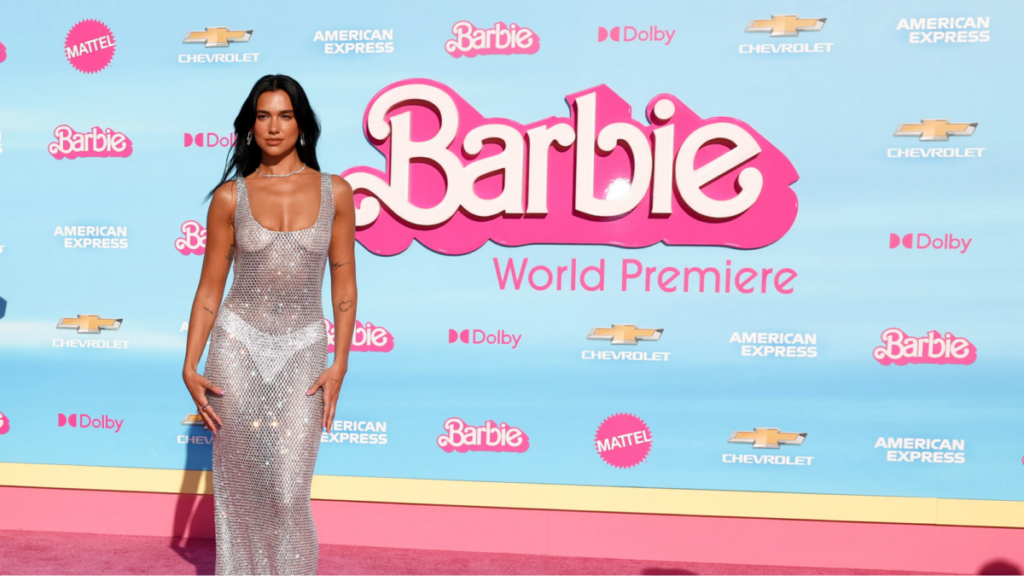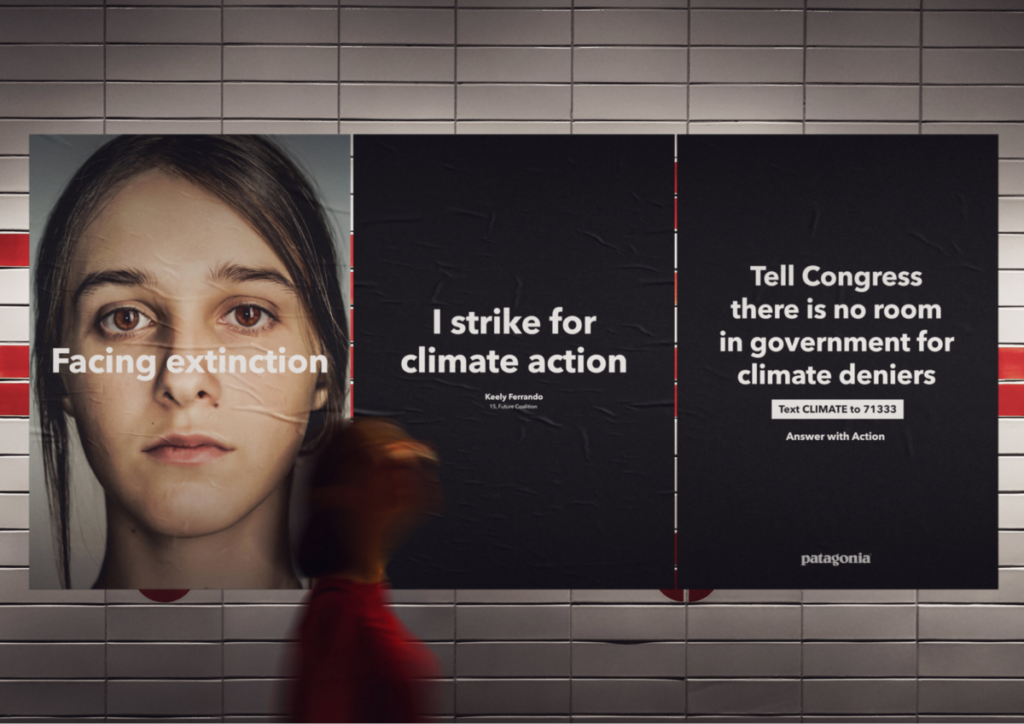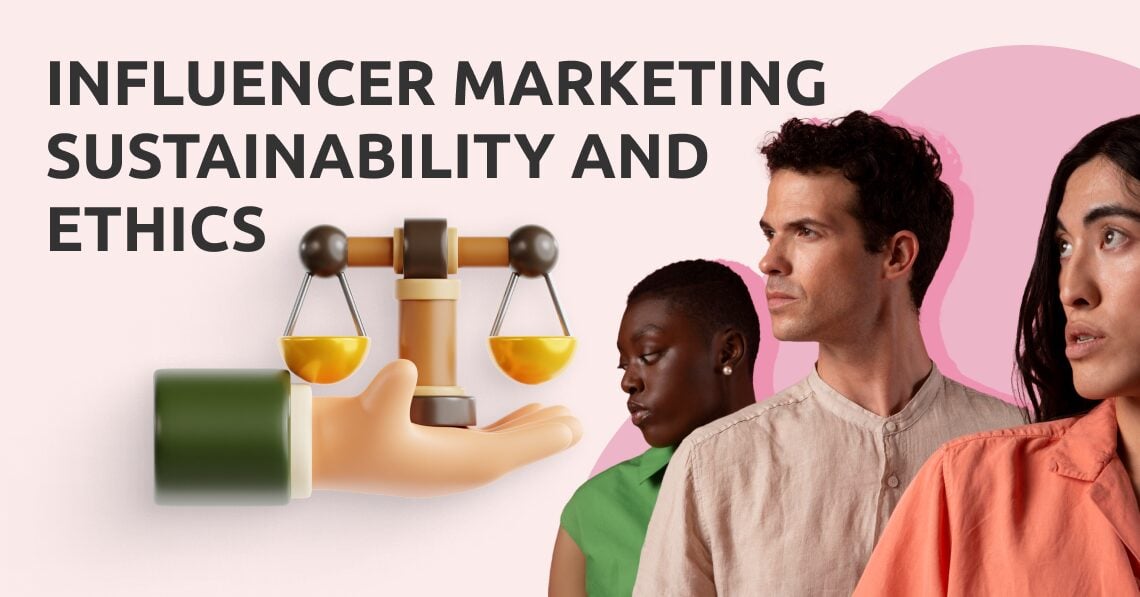She wasn’t just drinking coffee; she was reshaping a brand. Charli D’Amelio, TikTok’s biggest star, filmed herself sipping her favorite Dunkin’ drink, caramel swirl cold brew in hand, with millions of followers tuning in. But this wasn’t a paid stunt.
Charli had been authentically endorsing Dunkin’ long before the partnership ever started. In a clever twist, Dunkin’ turned that genuine enthusiasm into a branded drink: “The Charli.” Within five days of launch, it wasn’t just cold brew flying off the shelves—Dunkin’s app saw a 60% surge in downloads, and cold brew sales jumped 45% overnight.
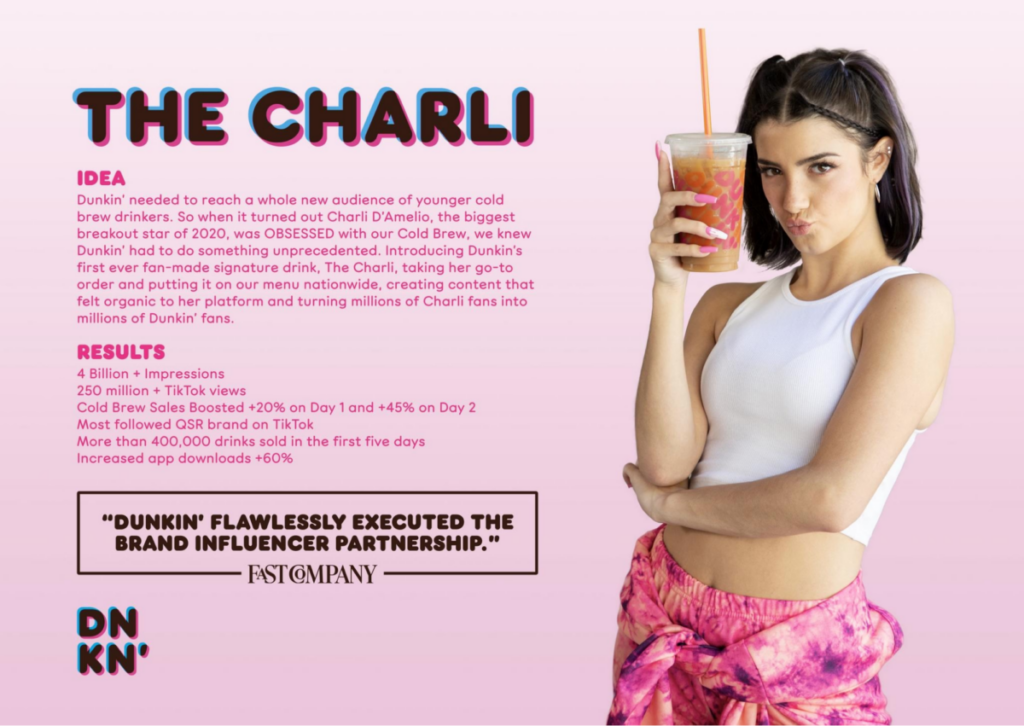
branded drink: “The Charli”
But what’s the magic in moments like these? How do brands like Lyft, Dior, and GymShark achieve viral momentum and measurable business success? These campaigns didn’t just ride on luck—they crafted strategies rooted in creative freedom, precision targeting, and real-time optimization.
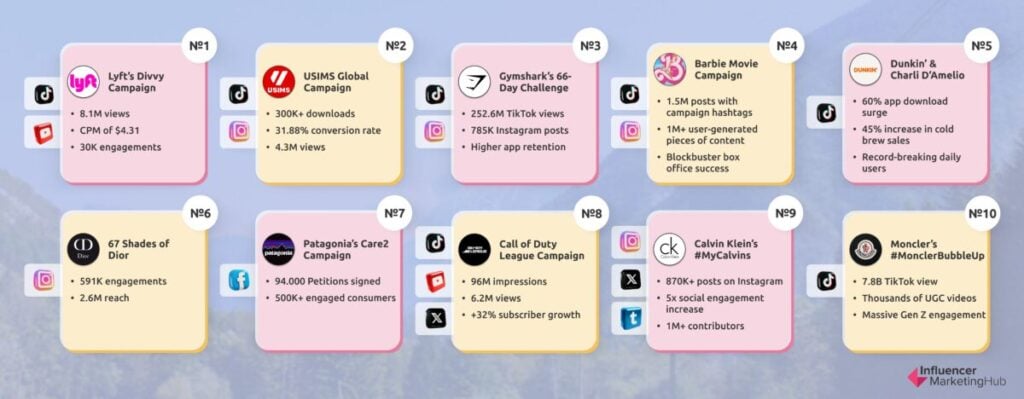
Top influencer marketing campaigns
Campaign | Strategy | Results |
Lyft’s Divvy Campaign (2024) | Multi-platform strategy using TikTok for awareness and YouTube for conversions. Local influencers promoted Chicago’s urban culture with storytelling. | |
USIMS Global Campaign | Localized influencer collaborations across 16 markets. Used micro-strategies and influencers to promote eSIMs in native languages. | |
Gymshark’s 66-Day Challenge | Community-driven UGC challenge encouraging users to share fitness journeys. Integrated with their Training App for engagement and tracking. | |
Barbie Movie Campaign (2023) | Celebrity endorsements, UGC templates (“This Barbie Is”), and brand collaborations across industries. Leveraged nostalgia and cultural relevance. | |
Dunkin’ & Charli D’Amelio | Product integration (“The Charli” drink) and TikTok challenges. Drove engagement by capitalizing on organic affinity and Gen Z’s love for TikTok. | |
67 Shades of Dior | 67 influencers representing different shades of the Forever Foundation. Focused on inclusivity and multi-platform storytelling. | |
Patagonia’s Care2 Campaign | Non-transactional partnerships with environmental influencers. Focused on sustainability and authenticity with product testing and storytelling. | |
Call of Duty League Campaign | Always-on strategy with influencers across YouTube, TikTok, and Twitter. Focused on immersive fan engagement throughout the season. | |
Calvin Klein’s #MyCalvins | Celebrity-led campaign encouraging UGC through personal storytelling and inclusivity. Leveraged multi-platform reach (Instagram, Tumblr, Twitter). | |
Moncler’s #MonclerBubbleUp | TikTok UGC challenge featuring Charli D’Amelio and top influencers. Used playful transitions into Moncler products for brand storytelling. |
Welcome to the era where influence isn't bought—it’s earned, curated, and amplified through the perfect blend of creativity, data, and technology. This report explores the "magic sauce" behind world-class campaigns, dissecting how top brands align influencer partnerships with platform dynamics, consumer behavior, and real-time data.
At the heart of every successful campaign lies a simple truth: Influence is an art, but results come from strategy. Each campaign in this report offers a glimpse into how the world’s most innovative brands turn influencer marketing into measurable business success.
What Makes the Top Influencer Marketing Campaigns Stand Out? A Framework for Success
Cracking the code of a great influencer marketing campaign isn’t like following a recipe—it’s more like cooking without one. It’s an art wrapped in strategy, fueled by creativity, strong relationships, and sharpened by data and precision. Unlike performance marketing, with its neat metrics like CTRs and CPA, influencer marketing plays out in a messy, unpredictable space driven by human behavior, trust, and cultural nuances. It’s a dance between authenticity and strategy, where improvisation is just as vital as planning.
So, if you’re after a foolproof formula—we hate to break it to you, but it doesn’t exist. The magic happens in the unexpected, the unscripted, and the real connections. Influence can’t be hacked; it must be earned, nurtured, and orchestrated.
That said, there are patterns in how the best campaigns navigate this complexity. By decoding these principles, we uncover a strategic consensus that reveals how top brands strike the perfect balance between creativity, authenticity, and precision.
1. Strategic Alignment: Trust-Driven Partnerships for Authentic Impact
Strategic alignment goes beyond finding influencers with large followings—it’s about building relationships that reflect a brand’s core mission and values. Consumers are increasingly drawn to authenticity, and brands that collaborate with influencers based on shared values earn not just visibility but also trust. According to a 2023 report by Edelman, 67% of consumers believe that brands gain trust through authentic alignment with influencers, driving long-term loyalty and advocacy.
Strategic alignment is also critical in mitigating consumer skepticism. A survey we did in 2024 found that 83% of consumers trust recommendations from influencers whose values align with their own. This approach not only strengthens the credibility of both the brand and influencer but transforms what might otherwise be transactional promotions into genuine advocacy efforts.
Now don't get us wrong, strategic alignment doesn't imply tight control over messaging but involves empowering influencers to organically convey the brand’s values.
2. Creative Agility: Empowering Influencers to Balance Structure and Freedom
The most compelling campaigns thrive at the intersection of structure and spontaneity. By providing influencers with guidelines and creative freedom, brands unlock authentic storytelling that feels relatable to audiences.
Content performs best when brands trust influencers to experiment within structured boundaries, leading to authentic and impactful storytelling.
Campaigns that strike the right balance between brand control and creative freedom foster engagement and authenticity, resulting in stronger consumer relationships.
3. Platform Precision: Leveraging Channels for Maximum Impact
Successful campaigns deploy platform-specific strategies to align with audience behaviors and leverage the strengths of each channel. Precision targeting ensures that messages resonate more deeply with audiences, maximizing engagement and ROI.
Precision targeting ensures that each campaign message resonates with the right audience, at the right time, on the right channel. This goes beyond simply cross-posting content—it requires understanding platform dynamics and how audiences engage with each medium.
The Ubiquitous Magic: Multi-Platform Strategy Done Right
Ubiquitous’ campaigns for brands like Lyft, Litter-Robot, and Wienerschnitzel show how channel mastery unlocks exponential impact. Each campaign is tailored for different audience behaviors, funnel stages, and budget constraints. Their “magic sauce” lies in:
1. Understanding Platform Strengths and Role Assignment:
Ubiquitous assigns distinct roles to each platform. TikTok is treated as a top-of-funnel platform ideal for creating buzz and viral moments through short, playful videos. Meanwhile, YouTube plays a lower-funnel role by offering deeper, informative content that drives conversions.
2. Full-Funnel Strategy Execution:
Ubiquitous uses a blend of awareness and conversion strategies across platforms, ensuring that audiences are guided down the funnel effectively. For Litter-Robot, TikTok and Instagram drove awareness through influencer creativity, generating 66.6 million views and 93,000 site visits. On YouTube, influencers reviewed the high-end product, targeting high-intent buyers with detailed features and usage insights. This approach ensured both top-of-mind awareness and bottom-line conversion—something many brands struggle to balance.
3. Cross-Platform Synergy and Content Amplification:
Ubiquitous amplifies content across channels while keeping messaging contextual to each platform’s audience.
4. Proprietary Data and Precision Targeting:
One of Ubiquitous’ key advantages is its use of proprietary technology to select the right creators for each platform and audience segment.
The campaigns driven by Ubiquitous highlight several key takeaways for brands looking to maximize platform potential:
- Precision beats breadth: Casting a wide net isn’t enough. Campaigns must align content with platform dynamics, whether it’s TikTok’s playful vibe or YouTube’s detailed reviews.
- Synergy matters: Encouraging influencers to post across platforms amplifies reach while keeping messaging authentic, reducing CPM and driving engagement.
- Funnel clarity unlocks ROI: Platforms should align with specific funnel stages—awareness on TikTok and Instagram, conversion on YouTube—ensuring every platform performs optimally.
This multi-channel precision showcases Ubiquitous’ ability to connect the dots between platforms, audiences, and creative strategies, making them a leader in influencer marketing. Through deliberate platform allocation, data-driven influencer selection, and fostering creative freedom, Ubiquitous proves that when each piece of the puzzle fits perfectly, the result is a campaign that not only performs but also inspires.
Key Insight:
Precision in platform strategy beats breadth. Campaigns that optimize content for each platform achieve deeper engagement and more sustainable results than those relying on cross-posting.
Takeaway:
The best campaigns don’t just pursue reach—they pursue relevance by aligning content with platform strengths, ensuring meaningful engagement.
Top Influencer Marketing Campaign Examples In the World
#1 Moncler’s #MonclerBubbleUp Challenge: A TikTok Triumph in UGC Marketing
In December 2020, Moncler launched the #MonclerBubbleUp challenge on TikTok, enlisting Charli D’Amelio—the platform’s most-followed star—alongside other influencers like Bella Poarch, Michael Le, and Abby Roberts. The goal was to boost brand awareness among Gen Z users by leveraging user-generated content (UGC). This viral campaign invited participants to wrap themselves in creative items such as bubble wrap or sleeping bags, mimicking Moncler’s signature puffy jackets, before transitioning into actual Moncler coats using TikTok’s editing tools.
The core objective was to align Moncler’s iconic products with fun, playful content while establishing relevance on a youth-dominated platform. By capitalizing on the creativity of TikTok users, Moncler aimed to create buzz, foster engagement, and enhance brand storytelling in a way that felt authentic to a Gen Z audience.
Key Campaign Outcomes:
- Total Views: 7.8 billion on TikTok
- Participant Engagement: Thousands of user-generated videos created
- Celebrity Impact: Featured influencers such as Charli D’Amelio amplified reach
- Brand Relevance: Successfully engaged Gen Z audiences and aligned Moncler with youth culture
- Paid Media Strategy: Leveraged TikTok’s platform tools to maximize exposure through paid sponsorship
Strategy and Tactics: UGC and Influencer-Driven Creativity
1. Strategic Influencer Collaborations:
Moncler’s partnership with Charli D’Amelio and other top influencers created immediate visibility for the campaign. As TikTok's most-followed personality, D’Amelio’s involvement ensured that the challenge reached millions of users right from the start.
2. User-Generated Content and Viral Participation:
The challenge encouraged participants to get creative with everyday items, such as sleeping bags and bubble wrap, which mirrored the brand's puffy designs. By seamlessly integrating TikTok’s editing tools—allowing for quick, visual transitions into Moncler jackets—participants engaged in organic storytelling that felt both playful and brand-relevant.
3. Music Integration for Enhanced Engagement:
Moncler paired the challenge with “Bubble” by 24hrs and Ty Dolla $ign, a catchy track that complemented the campaign’s playful vibe. This use of music further incentivized participation and allowed users to create content that aligned with TikTok’s trend-driven culture.
4. Paid Hashtag Challenge for Maximum Reach:
While TikTok’s sponsored hashtag challenges can cost upwards of $150,000 per week, Moncler’s investment paid off. The campaign amassed over 7.8 billion views, demonstrating the power of viral UGC when executed effectively.
@moncler @ireneisgood have joined the #MONCLERBUBBLEUP challenge. 💭 Dive into your bubble. #Moncler ♬ Bubble (feat Ty Dolla $ign) - 24hrs
Creative Innovation and Results
The #MonclerBubbleUp challenge succeeded by combining influencer marketing, music, and UGC, making it one of the most engaging fashion campaigns on TikTok. The campaign’s playful nature and minimal barriers to participation encouraged users to engage with the brand authentically.
Why This Campaign Stands Out
Moncler’s #MonclerBubbleUp challenge is a case study in how fashion brands can harness the power of TikTok’s UGC ecosystem to create viral content. The campaign’s success demonstrates that by integrating influencers, trends, and creativity, luxury brands can effectively connect with younger audiences in authentic ways.
Key Learnings for Brands:
1. Harness UGC for Greater Authenticity:
Encouraging users to participate in creative challenges fosters organic engagement and deepens brand connection.
2. Partner with Top Influencers for Immediate Impact:
Influencers with large followings—like Charli D’Amelio—can amplify campaign reach and generate excitement early on.
3. Use Music to Enhance Campaign Appeal:
Integrating popular tracks aligns the campaign with current trends, making content more engaging and shareable.
4. Invest in Paid Hashtag Challenges for Maximum Reach:
While expensive, sponsored TikTok challenges can yield impressive engagement and visibility when executed well.
The #MonclerBubbleUp challenge exemplifies how luxury brands can step outside their traditional marketing strategies to connect with new audiences through playful, participatory campaigns. By leveraging TikTok’s platform tools and influencer ecosystem, Moncler not only increased brand visibility but also established itself as culturally relevant among Gen Z consumers.
#2 USIMS – The Power of Localization in Influencer Marketing
Overview and Campaign Goals
USIMS, an eSIM provider, embarked on an ambitious journey to break into 16 international markets, targeting a diverse audience across regions. Their challenge was to gain trust in highly competitive markets dominated by telecom giants like Verizon and T-Mobile, while driving global awareness and app downloads. With affordable, easy-to-use connectivity as their core value, USIMS aimed to become a household name in the eSIM space.
Key Results:
- 300,000+ app downloads across 16 regions
- 31.88% conversion rate—an outstanding benchmark in the eSIM industry
- 4.3 million views across platforms
- 6,400 new paying customers acquired through influencer-driven campaigns
This campaign wasn’t just about numbers—it was a test of cultural relevance and trust, with each market presenting unique challenges and opportunities.
Strategy and Tactics: Localization at Scale with NeoReach
To execute a campaign of this magnitude, USIMS partnered with NeoReach, an agency with deep expertise in multi-platform influencer marketing. NeoReach's task was to seamlessly localize the campaign for different regions, deploying micro-strategies tailored to local markets. Their work involved influencer marketing but extended further into SEO, ASO (App Store Optimization), and social media management, creating a well-rounded, always-on campaign. At Influencer Marketing Hub we are not really surprised by the success this campaign had with Steph Payas, Chief Marketing Officer and Chris Gonzales, Chief Digital Officer in the lead for the campaign - two of the most talented in the Influencer Marketing Space.
Their expert coordination and attention to cultural precision ensured smooth execution across all markets. The team’s hands-on involvement, along with strategic guidance, ensured the campaign’s success at every level—from influencer onboarding to performance tracking.
A Multi-Platform, Multi-Language Strategy
NeoReach adopted an “always-on” approach to sustain momentum throughout the campaign, integrating influencers across Instagram, TikTok, and YouTube.
1. Top-of-Funnel Awareness via Instagram and TikTok
- NeoReach activated 39 travel and lifestyle influencers across these platforms to promote USIMS organically in their native languages.
- Travel influencers were an ideal fit, as they could easily integrate the eSIM into real-life travel experiences. A key highlight was sending an influencer to the Paris Olympics, where the product received global exposure.
- Content ranged from informational to playful, including unboxing videos and travel tips that showed the value of USIMS.
2. Conversion and Education via YouTube
- While Instagram and TikTok drove awareness, YouTube served as a conversion channel. Influencers provided in-depth reviews and tutorials on using USIMS.
- With higher intent users actively searching for solutions like eSIMs, this platform enabled USIMS to target and convert engaged audiences.
Creative Execution and Campaign Results
Influencers were encouraged to showcase USIMS naturally within their personal content, with the freedom to adjust the messaging to fit local norms and preferences. This balance between strategic guardrails and creative freedom ensured that the campaign didn’t feel forced, contributing to authentic engagement.
The app’s visibility soared, with users organically interacting with content in multiple languages and leaving positive reviews. This campaign not only built brand credibility in new markets but also provided actionable insights for future growth.
#3 Gymshark – Building a Fitness Community with User-Generated Content (UGC)
Overview and Campaign Goals
Gymshark has redefined fitness marketing through its community-centric approach, leveraging user-generated content (UGC) and authentic influencer collaborations. The 66 Days: Change Your Life Challenge encapsulates Gymshark’s philosophy: transforming habits through small, sustainable steps while encouraging accountability and participation among users.
The campaign launched on January 1, 2019, promoting the idea that 66 days is the average time needed to form a new habit. This narrative aligned perfectly with Gymshark's values and empowered participants to commit to fitness goals, fostering deeper connections between the brand and its community.
Campaign Goals:
- Encourage community engagement by motivating participants to document their fitness journeys.
- Empower users to act as brand ambassadors through UGC.
- Drive massive exposure across TikTok and Instagram, generating buzz through influencers and users alike.
- Improve app retention and engagement through Gymshark’s Training App, reinforcing accountability and creating long-term user loyalty.
Strategy and Tactics: Creating a Movement through Influencers, UGC, and App Engagement
1. Influencer Partnerships as Engagement Catalysts
Gymshark collaborated with six key influencers, including the Rybka Twins (5.2M followers) and Laurie Elle (2.5M followers) on TikTok and Instagram. These influencers provided the initial momentum by sharing their personal fitness journeys and offering followers tips and encouragement to join the challenge.
2. User-Generated Content at Scale
The campaign encouraged participants to document their fitness progress by:
- Posting an initial photo on January 1 and a final update on March 7.
- Using branded hashtags such as #Gymshark66 and tagging @Gymshark to build a sense of community and accountability.
- Thousands of participants contributed UGC, fueling the campaign’s organic momentum and turning everyday users into brand ambassadors.
3. The Gymshark Training App: A Data-Driven Approach
In 2024, Gymshark integrated the 66 Days Challenge into its Training App, which served as the central hub for the challenge. Participants used the app to:
- Track their progress daily by completing three personalized habits across fitness, nutrition, and mindfulness categories.
- Receive notifications and motivational content, reinforcing engagement and retention.
- Gain access to exclusive events and content, such as free workout classes at Gymshark’s London flagship store.
This integration enhanced the campaign’s effectiveness by creating an acquisition and retention loop, ensuring users stayed engaged long-term within the native app ecosystem.
4. Gamifying the Experience to Encourage Participation
- Participants were incentivized with daily challenges and progress tracking tools.
- The top performers won a year-long supply of Gymshark apparel, boosting motivation and reinforcing community involvement.
- Exclusive invites to events added a social component, bringing participants together in real-life settings.
Creative Execution and Campaign Results
Gymshark seamlessly blended influencer content with UGC, amplifying the campaign’s reach across TikTok and Instagram. Influencers shared short-form videos demonstrating their routines, while Gymshark showcased participant stories in an IGTV series titled “Stories of the 66.”
Campaign Highlights:
- 252.6 million views on TikTok using #Gymshark66.
- 785,000+ posts on Instagram, reflecting extensive user engagement.
- Higher retention rates on the Gymshark Training App due to personalized tracking and community interaction.
- Increased brand loyalty as participants became long-term users, deeply connected to Gymshark’s mission.
Why This Case Stands Out
The 66 Days Challenge exemplifies Gymshark’s mastery of community-driven marketing by turning participants into advocates and brand ambassadors through UGC. By integrating the campaign into their Training App, Gymshark not only generated engagement but also created a sustainable retention model that reinforces daily app usage and deepens brand relationships.
Key Learnings from Gymshark:
1. UGC Builds Advocacy: Encouraging participants to share their progress transformed users into authentic brand ambassadors, fostering organic advocacy.
2. App Engagement Drives Retention: The integration of the campaign into the Gymshark Training App enhanced engagement and created a seamless loop for acquisition, retention, and loyalty.
3. Community Campaigns Deepen Brand Identity: The shared experience of completing the challenge strengthened participants' connection to the Gymshark brand.
4. Influencer Collaborations Fuel Momentum: Strategic partnerships with fitness influencers inspired participation and increased visibility across platforms.
The Gymshark 66 Days Challenge serves as a replicable model for brands aiming to build lasting relationships through UGC and community participation. Its combination of influencer marketing, app engagement, and gamification demonstrates how to create authentic connections, drive retention, and boost long-term loyalty.
#4 Barbie – Crafting a Global Phenomenon through Influencer Marketing
The Barbie movie exemplifies a masterclass in influencer marketing by leveraging nostalgia, cultural relevance, and massive collaborations to create anticipation long before its release. Launching a pre-release campaign that revolved around user-generated content (UGC) and celebrity endorsements, the goal was to engage audiences globally and generate viral momentum.
The campaign’s objectives included:
- Building global anticipation months before the release through UGC.
- Amplifying brand presence by working with influencers, celebrities, and other brands.
- Driving hype and cultural relevance, resulting in record-breaking engagement on social media.
Key Results:
- 1.5 million posts using #BarbieTheMovie and #BarbieMovie on Instagram.
- Over 1 million unique users creating Barbie-themed content.
- Enormous box office success, positioning Barbie as one of the top-earning films of 2023.
Strategy and Tactics: The Power of Nostalgia and Collaboration
1. Participatory UGC Campaign with “This Barbie Is” Template
- The campaign empowered influencers and fans to create customized posters with the “This Barbie Is” template, allowing users to reimagine themselves as Barbie characters.
- This UGC element sparked a viral trend across social media platforms, making Barbie a cultural moment, with everyone sharing their personalized posters under branded hashtags.
2. Celebrity and Mega-Influencer Collaborations
- The campaign featured celebrity partnerships with Dua Lipa, Ryan Gosling, and others. Celebrities actively participated in promoting the film, generating massive organic buzz and expanding the movie's reach to new audiences.
- The soundtrack, including artists like Nicki Minaj and Ice Spice, further fueled engagement with the music being widely shared on TikTok and Instagram.
3. Brand Partnerships for Ubiquity
- Collaborating with over 30 major brands, Barbie became ubiquitous across industries—appearing on ice cream, fashion lines, cosmetics, and even AirBnB stays. These partnerships reinforced Barbie’s presence in both physical and digital spaces.
4. Interactive Marketing and Meme Culture
- Barbie tapped into meme culture with lines like “She’s everything, he’s just Ken,” encouraging playful engagement. Memes spread organically across X (formerly Twitter), TikTok, and Instagram, maintaining the campaign’s visibility.
- A “Barbiecore” trend emerged, influencing fashion and design with its vibrant pastel colors, aligning with the movie’s aesthetic and amplifying the hype.
Creative Execution and Campaign Results
The campaign seamlessly integrated influencer content, brand collaborations, and nostalgic elements, resulting in a massive social media movement. Fans actively participated, posting UGC in unprecedented numbers, while partner brands leveraged Barbie’s iconic identity for their own marketing efforts.
Campaign Highlights:
- 1.5 million posts using campaign hashtags.
- A viral UGC campaign with over 1 million unique users contributing content.
- Crossover influence across industries, with brands like Mattel, Impala Skate, and Airbnb featuring Barbie-themed products and experiences.
- The soundtrack generated additional hype, further engaging TikTok and Instagram audiences.
Why This Case Stands Out
The Barbie campaign exemplifies how early engagement, influencer partnerships, and cultural relevance can elevate a marketing campaign into a global phenomenon. It combined nostalgia with modern-day marketing tactics, positioning Barbie not just as a movie but as a cultural event.
Key Learnings from Barbie:
1. UGC Drives Engagement: Giving users the tools to participate (like the “This Barbie Is” template) creates personal connections and viral moments.
2. Multi-Industry Collaborations Create Ubiquity: Strategic brand partnerships extended Barbie’s presence across industries, ensuring the campaign was unavoidable.
3. Nostalgia + Modern Relevance = Winning Formula: The campaign’s nostalgic appeal, combined with cutting-edge digital strategies, resonated with both millennials and Gen Z, ensuring wide engagement.
The Barbie movie campaign offers a blueprint for influencer marketing, demonstrating how storytelling, nostalgia, and partnerships can culminate in both cultural relevance and financial success.
#5 Dunkin' and Charli D'Amelio – A TikTok-Driven Campaign for Youth Engagement
Overview and Campaign Goals
Dunkin’s collaboration with Charli D’Amelio in 2020 exemplifies the power of influencer marketing done right. The partnership aimed to leverage D’Amelio’s massive reach among Gen Z audiences on TikTok to increase brand relevance and boost app engagement. Starbucks has traditionally dominated the social media conversation among younger users, so Dunkin’ needed a fresh strategy to tap into this demographic effectively.
The partnership was organic, rooted in D’Amelio’s genuine love for Dunkin’ drinks. By turning her favorite order into a branded product, Dunkin' successfully engaged with a younger audience, strengthened their brand identity, and increased app adoption.
How the Collaboration Came to Life
Before the partnership began, D’Amelio had already been organically promoting Dunkin' on her social media without a formal collaboration. As she mentioned:
“For a long time, I just shamelessly promoted them...until they gave me the opportunity. Since then, we’ve come out with two drinks.”
This authenticity provided a strong foundation for the collaboration. The campaign officially launched with “The Charli,” her favorite Dunkin’ drink—a cold brew with whole milk and caramel swirl. This move not only personalized the brand but also encouraged users to engage directly by ordering “The Charli” via Dunkin’s app.
Key Campaign Outcomes:
- Impressions: 4 billion+ impressions across platforms.
- TikTok Views: 250 million+ views from campaign-related content on TikTok.
- Sales Impact:
- Cold Brew Sales: +20% boost on launch day and +45% on the second day. Over 400,000 drinks sold in the first five days.
- App Engagement: 60% surge in app downloads post-launch. Dunkin' became the most-followed QSR brand on TikTok during this campaign.
Campaign Execution and Tactics
1. Product Integration: “The Charli” Drink
- Dunkin’ added “The Charli” as a menu item, allowing fans to feel connected to the influencer by ordering her favorite drink.
- The collaboration also included a second product release called “The Charli Cold Foam,” which offered a new take on her original drink, with added cold foam and cinnamon sugar topping.
2. Social Media Contests and Engagement
- Dunkin’ and Charli launched the “Charli x Dunkin’” contest, encouraging fans to post recreations of iconic Charli moments with Dunkin’. Winners were selected to join a virtual hangout with Charli, further enhancing user engagement and participation.
3. Influencer-Takeover Content Strategy
- D’Amelio took over Dunkin’s social media during the campaign, offering exclusive content like AR filters and TikTok challenges.
- Dunkin' promoted the collaboration on both TikTok and Instagram, making the campaign omnipresent across the platforms where Gen Z spends most of their time.
4. App-First Approach for Engagement and Retention
- Dunkin' incentivized users to order through their app by offering bonus points via their loyalty program, DD Perks®. This created a direct incentive for app downloads and usage while driving more traffic to the platform.
Why This Campaign Stands Out
Dunkin’s collaboration with Charli D’Amelio demonstrates several critical lessons in influencer marketing and app engagement:
1. Authenticity Drives Success:
The campaign was built on Charli’s genuine enthusiasm for the brand, which made the collaboration feel natural and engaging.
2. Leveraging Influencer Fit:
Charli’s appeal to Gen Z allowed Dunkin’ to expand its reach to a younger demographic more effectively than traditional marketing efforts.
3. Omnichannel Execution:
Although not as expansive across multiple platforms as some campaigns, Dunkin' concentrated efforts on high-impact platforms (TikTok and Instagram), where Charli’s audience was already active.
4. App-Driven Engagement and Retention:
Dunkin’ used the campaign as an acquisition and retention tool by tying the product launch to app-exclusive rewards and incentives.
Key Takeaways from the Dunkin'-Charli Collaboration
- Influencer authenticity builds trust: Organic engagement from influencers makes collaborations feel more natural and relatable.
- Aligning products with influencers enhances impact: Creating a product tied directly to the influencer strengthens the relationship between the brand and the audience.
- Incentives drive engagement: App-based campaigns with loyalty rewards help brands boost downloads, retention, and usage.
- Niche influencer marketing can yield mainstream results: While not every brand can partner with a mega-influencer, this campaign highlights the value of genuine brand affinity and strategic collaborations.
Dunkin’s collaboration with Charli D’Amelio showcases the power of leveraging influencer passion to enhance brand identity, grow social media engagement, and increase app-based customer retention. This campaign succeeded by fostering genuine connections with audiences and using multi-layered touchpoints to maximize participation and visibility.
#6 “67 Shades of Dior” – A Masterclass in Inclusive Beauty Marketing
In 2020, Dior launched the “67 Shades of Dior” campaign to promote its Forever Foundation line, which offers 67 unique shades to accommodate a wide range of skin tones. The campaign’s primary goal was to showcase diversity while increasing global awareness and brand engagement. Dior wanted to prove that every individual could find a perfect match within their product line, aligning with growing conversations around inclusivity in the beauty industry.
The campaign also aimed to generate re-usable content for Dior’s owned channels, making it not only a one-time engagement effort but a long-term branding opportunity.
Strategy and Tactics: Empowering Influencers and Consumers
1. 67 Influencers Representing 67 Shades
Dior partnered with 67 influencers, each selected to represent a unique foundation shade, turning the product range into a visual narrative of diversity. This included both macro- and micro-influencers from multiple global markets, such as the US, UK, Nigeria, France, and South Africa.
2. Digital Campaign Execution and Storytelling on Social
Over 67 consecutive days, Dior posted daily introductions on @diorbeautylovers’ Instagram stories, featuring each influencer and their shade, with captions like:
"Day 32 – meet Lizzie, she wears shade 4 Neutral"
This storytelling approach cross-promoted influencers' content with Dior’s channels, creating a two-way promotion loop that maximized visibility and engagement across different follower groups.
3. Logistics and Data Innovation with Buttermilk Agency
To streamline execution, Dior partnered with Buttermilk, a global influencer marketing agency. Buttermilk used sophisticated quantitative and qualitative filters to shortlist 500 candidates, narrowing them down to 67 ideal influencers. They also built a digital shade finder on a campaign-specific landing page, ensuring influencers could accurately match their foundation shade without visiting stores—minimizing logistical challenges.
4. Smart Content Repurposing for Long-Term Impact
Dior repurposed 72% of the 290 pieces of campaign content for use on their own platforms, turning influencer posts into shoppable assets, paid ads, and PR materials. This content lifecycle strategy ensured sustained impact well beyond the campaign period.
Creative Innovation and Results
The creative brilliance of the campaign lay in its systematic approach to diversity. The influencers were given freedom to present their shades authentically, while Dior maintained structured messaging about inclusivity. This balance between freedom and control fostered genuine engagement with both influencers and audiences.
Key Campaign Outcomes:
- Engagement Rate: 6.6%
- Total Engagements: 591,000
- Campaign Reach: 2.66 million
Why This Campaign Stands Out
The 67 Shades of Dior campaign is a prime example of how influencer marketing can drive meaningful conversations around diversity. The use of micro-influencers added credibility and personal touch, resulting in higher engagement and trust. By incorporating applicable technologies like shade finders and data-driven influencer selection, Dior demonstrated the power of smart logistics and tech integration in influencer marketing.
Key Learnings for Brands:
- Diversity Requires Intentional Planning:
Identifying the right influencers to reflect a broad spectrum of skin tones isn’t just marketing—it’s about representation and authenticity. - Content Repurposing Extends Campaign Life:
By re-using influencer content as ads and PR materials, Dior maximized ROI, ensuring the campaign’s impact was felt beyond Instagram. - Creative Freedom with Structure Boosts Engagement:
Dior’s blend of creative flexibility and strategic guidelines allowed influencers to tell authentic stories while staying aligned with the brand message.
This campaign reflects how influencer marketing can evolve beyond product promotion to become a platform for cultural conversations. It’s a perfect case study in balancing inclusivity, creativity, and technology, cementing Dior as a leader in inclusive beauty marketing.
#7 Patagonia’s Purpose-Driven Influencer Marketing: Authenticity at Its Core
Patagonia’s influencer marketing strategy is deeply rooted in sustainability and climate advocacy, positioning the brand not just as a retailer but as a movement for environmental change. The goal is to inspire communities, build long-term relationships with environmentally conscious influencers, and promote authenticity without financial incentives for ambassadors.
By collaborating with athletes, adventurers, and environmentalists, Patagonia aims to reflect shared values, foster genuine engagement, and drive climate action. This approach aligns with their broader philosophy—illustrated by donating profits to nonprofits like the Holdfast Collective, which focuses on environmental protection.
Key Campaign Outcomes:
- CO2 Reduction: 75% reduction in CO2 emissions per product since 2008
- Audience Growth: Half a million engaged consumers through targeted campaigns
Strategy and Tactics: Aligning Values with Influencer Collaborations
1. Collaboration with Mission-Driven Influencers:
Patagonia partners with over 2,000 ambassadors from various outdoor disciplines, such as rock climbing, surfing, and trail running. Influencers like Tommy Caldwell and Marie-France Roy integrate Patagonia products into their everyday activities, showcasing real-world product utility and inspiring their communities to align with sustainable lifestyles.
2. No Direct Payments to Influencers:
Patagonia's ambassador program is non-transactional; no financial compensation is provided. Instead, the brand focuses on shared missions, building partnerships rooted in mutual trust and environmental advocacy, reflecting their principle of “low profits and no profits.”
3. Community-Generated Content and Real-World Product Testing:
Patagonia encourages ambassadors to test products in extreme outdoor environments, ensuring the gear meets high performance and sustainability standards. Additionally, the brand reshapes user-generated content from its community, amplifying authentic brand stories across multiple channels.
4. Data-Driven Campaigns with Strategic Targeting:
For collaborations like the one with George Fisher in the Lake District, Patagonia employs precise audience targeting through remarketing and custom audience segmentation. This ensures their content resonates with the right individuals, maximizing impact.
Creative Innovation and Results:
Patagonia’s campaigns blend structured storytelling with organic content creation. Influencers are given creative freedom to share their experiences authentically, while the brand curates and reshapes their content for broader reach.
Why This Campaign Stands Out:
Patagonia’s purpose-driven strategy proves that authenticity and sustainability can build long-term loyalty and community trust. By prioritizing shared values over financial incentives, the brand creates genuine connections with consumers, establishing itself as a leader in ethical marketing.
Key Learnings for Brands:
1. Align Influencer Partnerships with Mission-Driven Goals:
Collaborate with influencers who genuinely align with your brand’s mission, ensuring authenticity and credibility.
2. Leverage Community Content for Deeper Engagement:
Encourage and repurpose user-generated content to strengthen audience connections and amplify brand messaging.
3. Use Data-Driven Targeting for Maximum Impact:
Employ precise targeting strategies to engage the right audience and maximize campaign effectiveness.
4. Authenticity Over Transactions:
Patagonia’s approach demonstrates that non-paid partnerships rooted in shared values can foster long-term loyalty and high engagement.
This case study exemplifies how Patagonia’s influencer marketing transcends traditional product promotion to become a platform for environmental advocacy. Their approach serves as a model for brands looking to build sustainable growth through authenticity, community engagement, and purposeful partnerships.
#8 Call of Duty League’s Explosive Growth Campaign: Turning Casual Gamers into Active Fans
To grow viewership, expand the fanbase, and increase subscriptions for Call of Duty League (CDL), Activision Blizzard Esports (ABE) partnered with Viral Nation to create a season-long, always-on award-winning influencer campaign. The campaign focused on converting casual gamers into active, engaged fans while building sustained excitement for official broadcasts over the seven-month season. With CDL being one of the world’s premier esports leagues, the campaign aimed to cement its status as a leading esports event.
Viral Nation’s approach focused on integrated influencer partnerships to engage audiences across multiple platforms. The campaign's primary objectives were to:
- Grow CDL’s subscriber base and increase viewership for broadcasts.
- Drive awareness and engagement across platforms like YouTube, TikTok, Instagram, and Twitter.
- Sustain fan interest and hype leading up to Championship Weekend, the league’s pinnacle event.
Key Campaign Outcomes:
- Subscriber Growth: +32% Year-over-Year
- Impressions: 96 million
- Views: 6.2 million
- Exceeded ABE’s Goals by: 77%
- Championship Weekend: The most-viewed esports event since 2020
- Game Sales: Call of Duty became the best-selling video game of the year
Strategy and Tactics: A Comprehensive Influencer Ecosystem
1. Always-On Ambassador Program Across Multiple Platforms:
Viral Nation orchestrated an ambassador program with eight top-tier influencers from the Call of Duty ecosystem. These influencers engaged their audiences with CDL-related content throughout the season, building excitement from launch day to Championship Weekend. The ambassadors produced a blend of videos, mobile games, social media posts, and interactive content to immerse fans in the CDL experience.
2. Cross-Platform Integration for Maximum Reach:
The campaign utilized multiple social platforms to tailor content for specific audiences. The ambassadors created exclusive content across YouTube, Twitter, Instagram, and TikTok, ensuring CDL’s message reached both existing and new fans in the right context.
3. Immersive Fan Engagement:
Beyond simple promotion, the influencers participated actively in official CDL events, cheering alongside fans and creating a sense of community. This engagement blurred the lines between influencer-driven content and official broadcasts, making fans feel part of the CDL journey.
4. Data-Driven Targeting to Enhance Campaign Impact:
Viral Nation employed data-driven targeting techniques, ensuring that influencer content reached the right audiences. Custom audience creation and remarketing campaigns helped drive continued engagement with CDL broadcasts, maximizing impressions and subscriptions.
Creative Innovation and Results: Viral Growth with Record-Breaking Numbers
The campaign’s success lay in its immersive storytelling, which kept fans connected throughout the seven-month season. Viral Nation’s innovative approach not only promoted CDL broadcasts but also cultivated a loyal community of gamers, turning casual players into dedicated fans.
This campaign earned Viral Nation Platinum Honors at the 2022 AVA Digital Awards, highlighting its outstanding performance in digital marketing and social media campaigns.
Why This Campaign Stands Out:
The CDL campaign exemplifies the power of an always-on influencer strategy combined with multi-platform storytelling. Viral Nation’s community-first approach ensured authentic engagement, while data-driven targeting maximized the campaign’s impact.
Key Learnings for Brands:
1. Employ Always-On Strategies for Sustained Growth:
Continuous engagement ensures that fan interest remains high throughout the campaign, driving long-term loyalty and conversions.
2. Leverage Multi-Platform Storytelling:
Tailoring content to specific platforms helps brands engage diverse audience segments effectively.
3. Foster Immersive Community Engagement:
Involving influencers in real-time events creates authentic connections with audiences, fostering excitement and loyalty.
4. Use Data-Driven Targeting for Maximum ROI:
Precise targeting and audience segmentation optimize campaign effectiveness, ensuring the right messages reach the right fans.
This campaign demonstrates how hyper-targeted influencer strategies can drive record-breaking growth in esports. By merging immersive fan engagement with innovative storytelling, Viral Nation propelled the Call of Duty League to new heights—transforming it into one of the most successful esports campaigns of the year.
#9 Calvin Klein’s #MyCalvins Campaign: Redefining Fashion Marketing Through Influencer Power
Overview and Campaign Goals:
Launched in 2014, Calvin Klein’s #MyCalvins campaign aimed to connect the brand with a new generation by focusing on individual expression and authenticity. The campaign featured high-profile influencers like Justin Bieber and Kendall Jenner, encouraging both celebrities and everyday users to share photos and stories wearing Calvin Klein products. The goal was to create a viral movement, boost brand visibility, engagement, and foster body positivity across social media.
The campaign has since evolved beyond underwear to promote denim and other collections, maintaining momentum with updated hashtags such as #ProudInMyCalvins, which embraced inclusivity and representation, including the LGBTQIA+ community.
Strategy and Tactics: Celebrity Power Meets User-Generated Content
1. Leveraging Celebrity and Influencer Partnerships:
The campaign’s success was driven by its alignment with prominent influencers and cultural icons like Justin Bieber and Kendall Jenner, who have vast social media followings. Their participation lent credibility to the campaign and elevated Calvin Klein’s cultural relevance among Millennials and Gen Z.
2. Encouraging Participation Through a Simple Hashtag:
The campaign invited users to complete the phrase “I ______ in #MyCalvins” with personal stories, making the campaign highly relatable and interactive. This strategy transformed everyday consumers into brand advocates, creating a sense of community through self-expression.
3. Multi-Platform Integration:
While Instagram was the primary platform, #MyCalvins extended to Twitter, Tumblr, and Facebook, ensuring the brand’s message was accessible across different social platforms. Calvin Klein maintained consistent messaging and content across channels, reinforcing brand recognition.
4. Fostering User-Generated Content and Inclusivity:
The campaign successfully encouraged over 870,000 posts on Instagram, turning consumers into active participants in Calvin Klein’s narrative. Notable spin-offs like #ProudInMyCalvins highlighted diverse identities, promoting body positivity and inclusion.
Creative Innovation and Results
The campaign’s simplicity and viral nature were key to its success, creating a movement that blurred the lines between celebrity endorsement and community engagement. With a focus on authentic storytelling, Calvin Klein leveraged both paid and organic content, allowing participants to feel directly connected to the brand.
Key Campaign Outcomes:
- Instagram Posts: 870,000+ posts featuring #MyCalvins
- User Engagement: 5X increase in social media engagement
- Celebrity Influence: Justin Bieber’s campaign post received over 1.6 million likes, driving massive engagement
- User Participation: 1 million+ unique users contributed content
- Brand Visibility: Significant growth in followers across Instagram, Twitter, and Facebook
Why This Campaign Stands Out:
Calvin Klein’s #MyCalvins campaign exemplifies the power of influencer marketing combined with user-generated content. The brand successfully created a viral movement by empowering everyday consumers to share their Calvin Klein stories, amplifying the campaign’s reach far beyond traditional advertising. Its emphasis on inclusivity and cultural relevance has made it one of the most successful fashion marketing campaigns of the decade.
Key Learnings for Brands:
1. Empower Consumers to Co-Create Campaigns:
By encouraging users to share their stories, brands can foster a sense of community and create more authentic connections.
2. Use Celebrity Influence Strategically:
Well-chosen influencers can dramatically amplify a campaign’s visibility, especially when their personal values align with the brand.
3. Promote Inclusivity for Stronger Impact:
Inclusive campaigns resonate with broader audiences, promoting positive brand sentiment and loyalty.
4. Maintain Consistent Multi-Platform Messaging:
A unified presence across platforms reinforces brand recognition and ensures maximum campaign impact.
The #MyCalvins campaign demonstrates how influencer marketing can transcend product promotion to become a platform for self-expression and community engagement. By seamlessly blending celebrity power with user-generated content, Calvin Klein has solidified its place at the forefront of modern fashion marketing.
#10 Lyft’s Divvy Campaign – Mastering Urban Mobility with Influencer Precision
Overview and Campaign Goals
In June 2024, Lyft partnered with Ubiquitous to boost brand awareness and promote the use of Divvy scooters and bikes in Chicago’s highly competitive urban mobility market. The campaign's primary objective was to establish Divvy as the go-to transportation option before the short summer season ended, driving brand recognition and user engagement through local influencer marketing.
@visualsbyjack Welcome to a day in my life! From getting to classes on time, to plans with friends, I constantly find myself riding the Lyft scooters! You can find these scooters at your local Divvy station! Today consisted of scootering to class, my local cafe and a scooter ride downtown. Summertime is the perfect time for a scooter ride! Use my code “TRYDIVVYJACK” for a free unlock on @Lyft (or click the link in my bio) 🛴 #DivvyPartner and @divvybikes. P.S. my code is valid until September 15th, 2024! #lyft #electricscooter #thingstodoinchicago #dayinmylife #dailyvlog ♬ Relax - Neto0_0
The campaign had three specific KPIs:
- Impressions: Generate between 800,000 and 1 million impressions with a target CPM under $15.
- Activations: Achieve a 1% conversion rate with 8,000–10,000 new activations using the influencer's promo code.
- Engagement: Secure 300,000 organic impressions (500,000 was the stretch goal).
Strategy and Tactics
Ubiquitous campaigns are the perfect example of platform precision and multi-channel strategy. Ubiquitous divided the campaign into three phases: recruitment, creation, and activation, using TikTok, Instagram, and YouTube strategically:
1. TikTok and Instagram for Awareness (Top of Funnel):
- 60% of the budget went to TikTok and Instagram, leveraging their broad reach and viral potential.
- Influencers like @visualsbyjack and other local creators were given creative freedom to explore and promote Chicago’s hidden gems, aligning the content with the city’s culture.
- Posts on both platforms included promo codes for free unlocks, incentivizing engagement and driving trial usage.
2. YouTube for Conversion (Bottom of Funnel):
- 25–30% of the budget was allocated to YouTube, where longer-form content from creators provided detailed insights and reviews of the Divvy experience.
- YouTube’s role was to engage high-intent consumers actively searching for urban transport solutions, aligning with their decision-making process.
3. Cross-Platform Synergy:
- Ubiquitous negotiated cross-posting from TikTok to Instagram, boosting organic reach without increasing costs.
- Influencers were encouraged to post organically beyond their deliverables, turning them into brand ambassadors rather than mere promoters.
Creative Execution and Results
The creative aspect of the campaign was just as critical to its success. Influencers were empowered to inject their own storytelling style, whether through day-in-the-life videos, scenic rides through the city, or discovery of Chicago landmarks. This authenticity allowed content to resonate deeply with local audiences.
One standout post by @visualsbyjack documented a day spent biking through Chicago, capturing the joy of urban exploration. His TikTok alone generated over 20.7 million views during the campaign’s amplify stage, proving the power of influencer storytelling combined with local relevance.
Overall Campaign Results:
- 8.1 million views across platforms.
- 30,000 engagements with a highly efficient CPM of $4.31.
- Thousands of new Divvy users and significant buzz about Lyft’s urban mobility solutions.
Why This Case Stands Out
Lyft’s Divvy campaign showcases a masterclass in multi-platform strategy. Its effectiveness lies in assigning precise roles to each platform, from TikTok’s viral potential to YouTube’s deeper engagement. Lyft’s strategic use of local influencers, budget allocation, and seamless platform synergy demonstrates how brands can extract maximum value from influencer marketing while staying under budget.
This campaign perfectly illustrates the importance of:
- Funnel clarity: Using each platform to address a specific stage of the customer journey.
- Creative freedom with structured goals: Allowing influencers to create content that resonates with their audience while staying aligned with the campaign’s objectives.
- Cross-platform amplification: Encouraging multi-channel posting to reduce costs and boost organic reach.
The 8.1 million views, CPM of $4.31, and the positive impact on Divvy’s usage prove that platform precision combined with creative freedom leads to impactful, measurable outcomes.
The Common Thread of Greatness: A Reflection on the World’s Best Influencer Marketing Campaigns
The brilliance behind these campaigns isn’t just in reaching millions or trending on social media for a week. It’s in how they ignite movements, foster authentic connections, and bridge the gap between brands and communities in ways traditional advertising never could.
At the heart of every exceptional campaign—whether it’s Patagonia’s purpose-driven approach, Gymshark’s community-building with #Gymshark66, or Moncler’s playful #MonclerBubbleUp challenge on TikTok—is authenticity. The influencers involved in these campaigns aren’t just brand mouthpieces; they embody the ethos of the products they promote. Patagonia’s athletes and adventurers use their gear not because they were paid to, but because they live by the same environmental values the brand upholds. Charli D’Amelio didn’t just pitch Dunkin’; her campaign felt natural because she had already embraced the brand in her everyday life. And that authenticity, when carefully aligned, becomes a mirror—a reflection of the values, aspirations, and experiences the audience themselves want to live by.
But authenticity alone isn’t enough. These campaigns work because they also understand where and how to engage audiences. The secret is precision. Lyft’s Divvy campaign showed us that successful marketing isn’t about being everywhere—it’s about being in the right places with the right content. TikTok drives quick engagement, YouTube offers space for in-depth exploration, and Instagram captures moments that resonate emotionally. This platform mastery allows brands to not just broadcast messages but engage meaningfully at every stage of the customer journey, from curiosity to conversion.
And what stands out across all these campaigns is the emphasis on participation and belonging. Gymshark asked its audience to not just watch but to become the brand by sharing their journeys and building habits. Barbie transformed nostalgia into a community phenomenon, inviting people across industries to reimagine themselves as part of its world through personalized “This Barbie Is” posters. Moncler’s TikTok challenge made every user a content creator, each video an extension of the brand’s playful identity. This is not marketing in the traditional sense—it’s co-creation. It’s turning customers into partners, participants, and storytellers in a shared narrative.
Then there is the science behind the art, the data-driven brilliance that powers these campaigns. Brands like Barbie, Lyft, and Call of Duty League didn’t rely on luck to hit their targets; they used insights to meticulously optimize campaigns in real time. They segmented audiences, tested creative content, and refined messages to resonate with different cultures, regions, and niches. Data became the unseen hand that transformed creativity into measurable business impact, showing that storytelling and metrics are not opposing forces—they are complementary.
Ultimately, the greatest campaigns aren’t just about selling products—they are about building cultural relevance and lasting trust. They align with real human values—whether sustainability, self-expression, nostalgia, or community—and they do so with integrity. In this way, they transcend marketing and become movements, conversations, and, most importantly, relationships that extend far beyond the transactional.
These campaigns remind us that influencer marketing isn’t just a strategy; it’s a philosophy. It’s about finding those intersections where brand values meet human stories, where creativity meets data, and where partnerships feel more like friendships. And when done right, the result is not just a spike in sales or a viral trend—it’s loyalty. It’s belonging. It’s becoming a part of people’s lives in a way that cannot be easily replaced or forgotten.
This is the essence of brilliant influencer marketing: authenticity, precision, participation, and trust, all working together in harmony to create not just campaigns but movements. And that, perhaps, is the most valuable lesson of all—because when brands stop trying to sell and start trying to belong, that’s when the magic truly happens.
